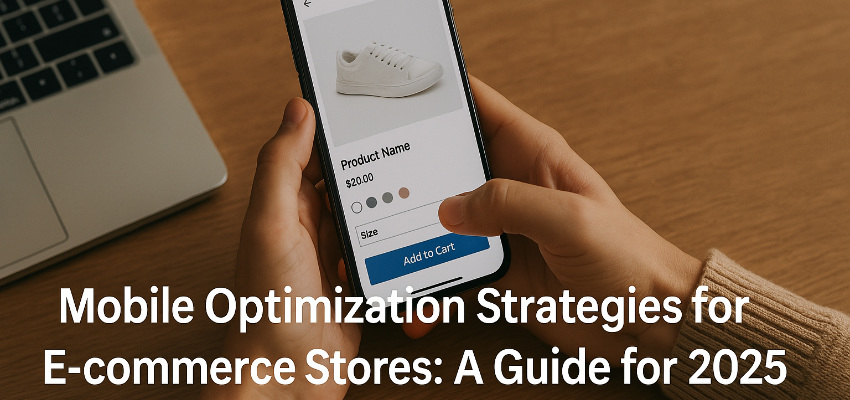Show:
Mobile Optimization Strategies for E-commerce Stores: A Guide for 2025
Over 70% of online shoppers use their phones to shop, making mobile optimization a priority for e-commerce businesses in 2025.
If a page takes too long to load or the checkout process has too many steps, customers drop off without hesitation. They expect a seamless experience—clear product images, fast-loading pages, and easy navigation.

However, most e-commerce websites still struggle to meet these expectations.
Creating a mobile experience that’s fast, intuitive, and designed for how people actually shop is the real challenge. Shoppers scroll quickly and make split-second decisions. You’re losing sales if your store isn’t built for this behavior.
This guide shares effective mobile optimization strategies, from improving page speed to streamlining checkout.
Key Strategies to Optimize Your E-commerce Store for Mobile
Improve Page Loading Speed
If a page takes too long to load, visitors won’t wait around. Over 50% of mobile users abandon sites that take longer than 3 seconds to load.
Here’s how you can improve page loading times:
- Optimize Images: Large image files are often the main cause of slow loading times. Use image compression tools to reduce file size without compromising image quality.
- Implement Lazy Loading: With lazy loading, images and content load only when they are visible on the user’s screen. This ensures quicker initial load times.
- Minimize JavaScript and CSS: Heavy, unoptimized code can slow down your site and frustrate users. To speed up your site’s performance, start by removing unnecessary whitespace, comments, and any code that’s not actively being used. Shorten variable names and simplify functions to reduce file sizes.
- Use a CDN: A Content Delivery Network delivers your site’s content from a server closer to the user. This minimizes loading delays, especially for global audiences.
Optimize Product Pages for Mobile
Mobile users want quick access to information and a smooth shopping experience. Here’s a breakdown of exactly how to optimize your product pages:
- Highlight Key Information Early: Highlight the most important details, like the main benefit or feature in the first line, followed by the material, dimensions, or unique selling point.
- Feature-Rich Media: Along with clear text, incorporate visuals that help convey the product’s features. Use images and videos where relevant to show how the product works or looks.
- Organize Content in Expandable Sections: Instead of overwhelming users with a wall of text, use collapsible sections or tabs for different content types, such as “Product Description,” “Size Guide,” “Customer Reviews,” and “Related Products.” This keeps everything neat and ensures that users can access information without endless scrolling.
- Include Size Charts: Use a size chart app for Shopify to display a dynamic, interactive size guide directly on the product page. This allows customers to quickly see how the product fits and reduces the chances of returns due to sizing issues.
Streamline the Mobile Checkout Process
Mobile checkout is an area where friction can easily cause customers to abandon their carts. It’s crucial to make the process as smooth as possible. Here’s how you can optimize it:
- Offer Guest Checkout: Requiring customers to create an account before purchasing is a major roadblock. Allow them to check out as guests instead. Once the purchase is complete, you can offer them the option to create an account for future convenience.
- Use One-Page Checkout: Avoid multi-step checkouts on mobile. Combine all fields like shipping, billing, and payment on a single page. Ensure the page is well-organized and the customer can clearly see what’s needed without scrolling too much.
- Enable Autofill and Simplified Forms: Let the browser autofill details like shipping and billing information. This speeds up the process and makes it easier for customers. Also, ensure your form fields are large enough for mobile users to fill out comfortably.
- Offer Mobile Payment Options: Make the payment process as easy as possible by integrating mobile-friendly payment methods like Apple Pay, Google Pay, or PayPal. These options allow customers to complete their purchase with just a tap, eliminating the need to manually input card details.

Advanced Mobile Features to Enhance User Experience
Personalization is essential for improving conversions. By delivering a customized experience, you can keep users engaged and increase sales.
Here are some personalization features you can add to enhance user experience:
- AI-Powered Product Recommendations: Use customer data, browsing history, and previous purchases to recommend products that are most relevant to the user. AI tools use machine learning algorithms to analyze behavior and deliver personalized suggestions. Display these recommendations on product pages, within the cart, or even on the checkout page to prompt additional purchases.
- Push Notifications: Use push notifications to keep the users engaged and increase sales. If a user leaves items in their cart, send a push notification to remind and encourage them to complete their purchase. You can also use notifications to alert customers to limited-time offers or flash sales.
Mobile Optimization Tools and Technologies
A/B Testing for Mobile Usability
A/B testing lets you see what works best for mobile users. Small tweaks can make a big difference in conversion rates.
- Test Layout Changes: Test changes like button size, colors, and product image placement to see how they impact user behavior. Even small design adjustments can improve user experience.
- Measure Conversions: While design improvements are great, the ultimate goal is conversions. Use A/B testing to determine which design and content changes bring more sales.
The Role of AI in Mobile Shopping Optimization
Artificial intelligence can help make mobile shopping more intuitive, personalized, and faster.
- AI-Powered Search: Use AI to enhance your site’s search functionality by delivering more accurate and relevant results. The technology recommends products based on the user’s browsing history and provides auto-suggestions for customers to find exactly what they’re looking for.
- Chatbots for Mobile Support: AI-driven chatbots can guide customers through their shopping journey, provide real-time support, and answer questions instantly with no human intervention.
Key Takeaways
Mobile optimization is a necessity for e-commerce success in 2025. Your store needs to be fast, intuitive, and frictionless. If your site loads slowly, has clunky navigation, or forces customers through a tedious checkout process, you’re losing sales.
To create a high-converting mobile shopping experience, start by improving page speed with optimized images, lazy loading, and a CDN. Ensure your product pages are clear, concise, and easy to navigate. Then, streamline your checkout process by enabling guest checkout, using autofill, and integrating mobile payment options like Apple Pay and Google Pay.
Use AI-powered recommendations, push notifications, and A/B testing to fine-tune the mobile experience and drive more conversions.

 Return to Previous Page
Return to Previous Page








